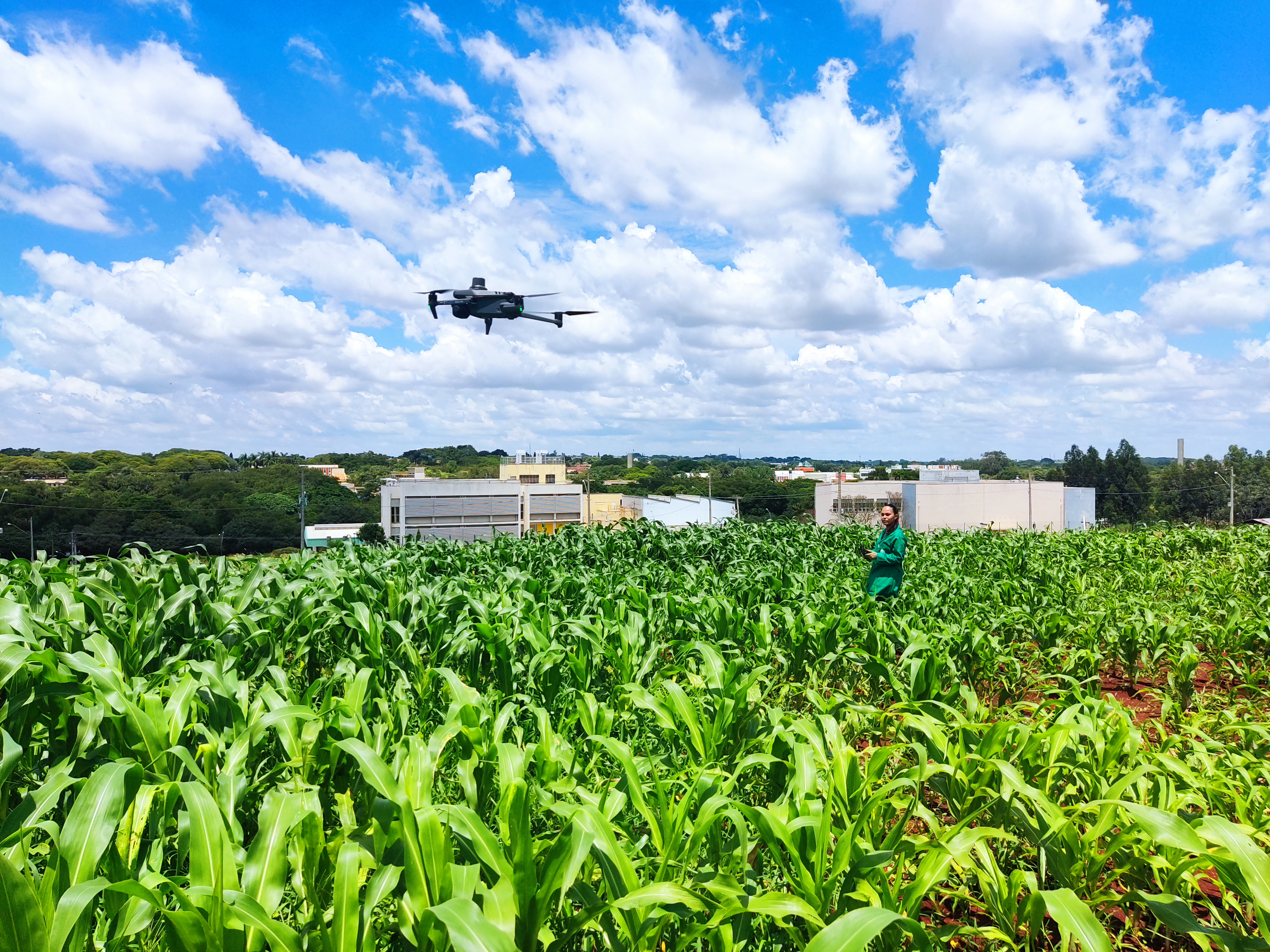

Researcher flies drone over experimental corn plantation in Campinas (state of São Paulo, Brazil): technology can facilitate the selection of drought-tolerant varieties (photo: Paula Drummond de Castro/GCCRC)
Images taken from an unmanned aerial vehicle, processed with free software, help assess water stress parameters in corn experiments and select varieties that are better adapted to water shortages.
Images taken from an unmanned aerial vehicle, processed with free software, help assess water stress parameters in corn experiments and select varieties that are better adapted to water shortages.

Researcher flies drone over experimental corn plantation in Campinas (state of São Paulo, Brazil): technology can facilitate the selection of drought-tolerant varieties (photo: Paula Drummond de Castro/GCCRC)
By André Julião | Agência FAPESP – A method using free software and a drone with a low-cost camera has made it possible to select drought-tolerant corn plants. The tool contributes to the selection of plants that can better withstand water stress, one of the impacts of climate change on agriculture.
The results of the experiments were published in an article in the Plant Phenome Journal.
The authors are associated with the Genomics for Climate Change Research Center (GCCRC), an Engineering Research Center (ERC) created with the support of FAPESP and the Brazilian Agricultural Research Corporation (EMBRAPA) at the State University of Campinas (UNICAMP), in the state of São Paulo, Brazil.
“Experiments with genetically modified plants are expensive. This method allowed us to assess the plants’ tolerance to drought in a relatively small area, using free software and a simpler RGB camera that captured the parameters of the experiment more effectively than the more expensive multispectral camera,” says Helcio Duarte Pereira, a researcher at the GCCRC with a scholarship from FAPESP and first author of the study.
The method allowed for optimized, faster and cheaper data collection. Conventional methods require manual measurements, sometimes with expensive equipment and slow processes. In addition, some characteristics can only be measured at the end of the plant’s life cycle. With the drone, the work that would otherwise take days can be done in a few hours, allowing plants to be assessed at different stages of growth.
The approach also makes it possible to follow the development of the plants throughout their growth cycle. “The continuous analysis, at different stages of the plant’s life cycle, was essential to understand how they respond to water stress, as well as making it possible to predict how they’d behave in other areas,” explains Juliana Yassitepe, a researcher at the GCCRC and EMBRAPA Digital Agriculture, who coordinated the study.
Water stress parameters
During the dry season of 2023, between April and September, the researchers carried out a series of flights at an experimental site in Campinas. The site was planted with 21 varieties of corn, three conventional and 18 genetically modified to overexpress genes potentially associated with resistance to water stress.
In the experiment, the only treatment difference between the plants was that half received irrigation throughout their life cycle, while the other half was subjected to drought.
Each flight lasted 10 minutes and yielded 290 images. The researchers selected 13 flights done with the multispectral camera, which captures non-visible spectra such as infrared, and 18 with the RGB camera, which is much cheaper and captures three colors or bands: red, green and blue.
The images were analyzed using free software that allowed the bands obtained in the images to be cross-referenced. To determine what the color differences in the images indicated, the researchers took a series of conventional measurements of the plants on the ground. From there, they were able to define the water stress parameters and calibrate the predictive models.
The results presented from the images from the cheaper camera proved to be more reliable and accurate, making the technology accessible for large-scale breeding programs.
As well as reducing operating costs, the method allows studies to be conducted in smaller areas, which is especially useful in projects with limited resources. “We don’t always have enough seeds to plant in very large areas, which is a bottleneck in this type of research,” says Yassitepe.
The researchers also point out that the drone’s lower flights allow it to obtain high-resolution images, which is justified in smaller experimental areas, helping to obtain more accurate data.
Finally, although it is not the main goal of the group, the breakthrough opens the way for other research groups or startups to develop applications directly aimed at producers or breeding companies.
“There are applications on the market that allow you to assess, for example, the chlorophyll in the plant and thus determine the nitrogen levels. This makes it possible to adjust fertilization as needed,” says Pereira.
For Yassitepe, the indices evaluated in the study can serve as a basis for the development of applications that make automated measurements of water stress in different agricultural or forestry crops.
The article “Temporal field phenomics of transgenic maize events subjected to drought stress: Cross-validation scenarios and machine learning models” can be read at: acsess.onlinelibrary.wiley.com/doi/10.1002/ppj2.70015.
Republish
The Agency FAPESP licenses news via Creative Commons (CC-BY-NC-ND) so that they can be republished free of charge and in a simple way by other digital or printed vehicles. Agência FAPESP must be credited as the source of the content being republished and the name of the reporter (if any) must be attributed. Using the HMTL button below allows compliance with these rules, detailed in Digital Republishing Policy FAPESP.





